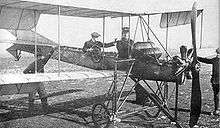Dufaux 5
| Dufaux 5 | |
|---|---|
 | |
| Role | Military aircraft |
| Manufacturer | Henri Dufaux |
| Designer | Henri Dufaux |
| First flight | 1910 |
|
| |

The Dufaux 5 is a two-seat airplane built by French-Switzerland aviation pioneers Henri and Armand Dufaux.
Construction and development
After Armand Dufaux had flown over the Geneva for its entire length with the Dufaux 4 on 28 August 1910,and the world record by Louis Blériot was significantly exceeded,[1] Armand and his brother Henri produced the first aircraft in Switzerland. In the months after the record flight of 28 August 1910, the Dufaux brothers undertook numerous other flights and participated with other flight pioneers - including Emile Taddéoli (1879–1920),[2] flying boat Pioneer until 1920,chief pilot of the later Ad Astra Aero who brought them to the United States. Previously they had received a considerable number of orders for those days that they intended to comply with the successor of experimental aircraft.
The record-breaking Dufaux 4 probably appreciated his powerful designers too little, as it provided space for only the pilot. The Dufaux 5 was designed by the brothers as Dufaux double.[3] The Dufaux 5 was designed based on the experience of Dufaux 4 and the remaining nameless model 2 with eight wings. The basic division of Dufaux 4 has been substantially expanded by one seat for a passenger and the Anzani aircraft engine was replaced by the 91-kilogram Gnome 70 Seven-cylinder-rotary engine supplying 53 kW(70 hp)of power. Otherwise, the aircraft differed little from similar structures from the pioneering years of aviation engine. The supporting structure of Dufaux 4 appears as the same total length, wing span and unchanged height, while the performance is increased despite the increased launch weight. The previously two ailerons between the wings was increased to four, arranged on the rear end of the wings as in today's designs.
Use
The biplane was manufactured from December 1910, in the company Mégevet, Corsier (where the Dufaux brothers had completed their initial flight tests) .The total number of manufactured aircraft should be at least 15 copies (including Dufaux 4) but it needs to be clarified.
The Swiss army had already rejected using the Dufaux 4 in May 1910, since their charge for military use seemed inappropriate. The now much improved Dufaux 5 led Ernest Failloubaz (1892–1919), the youngest pilot in Switzerland (who was 19 years of age at that time), to fly it. From 4 to 6 September 1911, before the Army leadership as observers in the maneuvers of the 1st Army Corps reconnaissance missions, he flew with his friend Gustave Lecoultre. There was a crash landing on the last day of the three-day operation of these flights to begin the Swiss military aviation.[4]
Dufaux was used from October 1911 at the Flight School founded by Emile Taddéoli in Viry, near Geneva. Ernest Failloubaz may have been the first owner of a Dufaux 5. He had ordered Dufaux 5 from the flight school in Avenches in November 1910, with which he has already conducted a test flight in the presence of Armand Dufaux, followed by an unknown number of passenger flights in the first half of January 1911. Armand Dufaux increased the production to 16 until 18 April at the air show at Viry in part, where he showed the airplane to the interested ones. A flight demonstration by Emile Taddéoli in Annecy crashed in Geneva, without any harm to humans and machines, and the flight demonstrations continued till July 1911. Presumably, from this point, the Aircraft Production has been discontinued by the brothers Dufaux, but three Dufaux aircraft were produced in Avenches, probably in the autumn of 1911.
Among the especially popular among owners of Dufaux 5 are Armand Dufaux, Emile Taddéoli, Ernest Failloubaz, François Durafour (1888–1967),[5] Cobioni and Beck. Charles Girod, Georges Cailler, Gustave Lecoultre, Hollinger, Beck and Knutti received flying lessons in the flight school of their chief pilot Durafour at Avenches in the course of 1911. The model was used in the School of Failloubaz probably at least until 1916.
Technical Data
| Performance indicator | Dufaux 5[6] | Dufaux 4 [1] |
| Length | 9.5 m | 9.5 m |
| Height | 2.7 m | 2.7 m |
| Wingspan | 8.5 m | 8.5 m |
| Wing area | 24,0 m² | 24,0 m² |
| max. Start Weight | 555 kg | 320 kg |
| Curb weight | 340 kg | 180 kg |
| Crew | pilot and passenger | Pilot |
| Drive | Gnome rotary engine with 53 kW (70 hp) | Anzani engine with 19 kW (25 hp) |
| Start Speed | 42 km/h | |
| Speed | 84 km/h (52 mph) | 60 km/h |
| First growing service | 0.3 m/s | |
| Ceiling | 600 m | 500 m |
| Wing loading | 23 kg/m | |
| Scope | 60 km (37 mi) (1 hour flight) | ~ 66 km (41 mi) (32-minute flight) |
Variants and whereabouts
As an alternative to the Gnome rotary engines, Oerlikon four-cylinder aircraft engines were also used. The Dufaux 4, as the oldest surviving Swiss aircraft is in the collection of the Swiss Transport Museum.[7]
Notes
| Wikimedia Commons has media related to Dufaux 5. |
- 1 2 spip.php? article219Pionniers Armand Dufaux 'record flight of 28 August 1910 to pionnair-en with a detailed description and photos (French)
- ↑ article178 Pierre Emile Taddéoli on pionnair-ge(French)
- ↑ The "Dufaux 4" on pionnair-en with information and photos (French)
- ↑ official website of the Swiss Air Force:The first Swiss Military Aircraft, accessed on 24 December 2008
- ↑ François Durafour on pionnair-ge (French)
- ↑ The Virtual Aviation Museum: Dufaux 5
- ↑ [The http://www.verkehrshaus.ch/index.cfm?dom=1&rub=79&id=100087 "Dufaux 4" in the Transport Museum in Lucerne], accessed on 23 December 2008